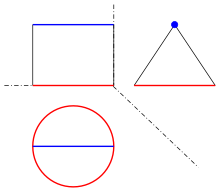Conoid
A conoid (from the Greek κωνος cone and -ειδης similar) is a ruled surface in mathematics , whose family of generators (straight lines) the two additional conditions
- (1) All generatrices of the surface are parallel to a plane, the straightening plane .
- (2) All generatrices intersect a fixed straight line, the axis .
Fulfills.
- The conoid is called straight if the axis is perpendicular to the alignment plane .
Because of (1) every conoid is a Catalan surface and can be represented by a parametric representation
to be discribed. Every surface curve with a fixed parameter is a generator, describes the guide curve and the vectors are all parallel to the straightening plane. The planarity of the vectors can be passed through with sufficient differentiability
express.
- If the trajectory is a circle, it means Konoid Kreiskonoid .
Comment:
- A conoid is unlimited (like a straight line). A graphic representation can therefore only ever show a finite part of the area.
- The term conoid was coined by Archimedes in his treatise on conoids and spheroids .
Examples
Straight circular conoid
The parametric representation
- describes a straight Kreiskonoid with the unit circle in the xy plane as a guide curve and a plane parallel to the yz-plane directional plane . The axis is the straight line
Special features : 1) Every horizontal section is an ellipse, 2) The outlines of the partial area shown in the picture with regard to the main directions are a rectangle, a circle and a triangle (see 2nd picture), 3) is an implicit representation, that is , the straight circular conoid is a surface of the 4th degree. 4) The Kepler barrel typically delivers in a straight Kreiskonoid with the base circle radius and height of the exact volume: .
The implicit representation is fulfilled by the whole straight line . There are no tangent planes at the points of this straight line . Such points are called singular .
Hyperbolic paraboloid
The parametric representation
-
- describes the hyperbolic paraboloid with the equation It is a surface of the 2nd degree ( quadric ).
The leading curve of this conoid is the straight line (red in the picture), the straightening plane is parallel to the yz plane. If you choose the x-axis as the axis, the conoid is straight . Since in this example the further straight line runs through every point of the surface in addition to the generating line , one of these further straight lines can also be selected as the axis. However, only the first-mentioned axis is perpendicular to the plane of alignment. In this case the x-axis could be selected as both the guide curve and the axis.
The hyperbolic paraboloid has no singular points.
Plücker conoid
The parametric representation
represents a Plücker conoid with the equation
- represent.
The guide curve is a path traversed twice on the z-axis, the axis of the conoid is the z-axis and the alignment plane is parallel to the xy-plane. Since the axis is perpendicular to the straightening plane, the conoid is straight .
The implicit representation is fulfilled by the entire z-axis. The points on the z-axis are singular (there are no tangent planes).
Whitney Umbrella
The parametric representation
represents a Whitney Umbrella with the equation . The surface is a conoid with twice traversed the positive z-axis as a guide curve , the z-axis as the axis and a plane parallel to the xy plane directional plane . Since the axis is perpendicular to the straightening plane, this conoid is also straight .
The implicit representation is also fulfilled by the negative z-axis, the handle of the umbrella. The points on the z-axis are singular (there are no tangent planes).
Parabolic conoid
The parametric representation
provides a parabolic conoid with the equation . The conoid having a parabola as a guide curve , the y-axis as the axis and parallel to the xz plane directional plane . Since the axis is perpendicular to the straightening plane, the conoid is straight . It is used in architecture as a roof surface (see Applications).
The parabolic conoid has no singular points.
Helical surface
The helical surface is also a straight conoid. It has no singularities.
Applications
In math
There are numerous simple examples of surfaces with singularities among the conoids .
In architecture
Like other ruled surfaces, conoids are used in architecture because they can be easily modeled from segments (beams, bars). Just Conoids can be very easily made: one threaded rods so on an axis that they can only rotate about this axis. Then you deflect the bars with the help of any guide curve and thus create a straight conoid. (See Parabolic Conoid.)
Web links
- mathworld: Plücker's Conoid
- mathcurve: Pluecker conoid
- mathcurve: parabolic conoid
- K3Dsurf: 3d surface generator
literature
- Small Encyclopedia Mathematics , Harri Deutsch-Verlag, 1977, p. 219.



































